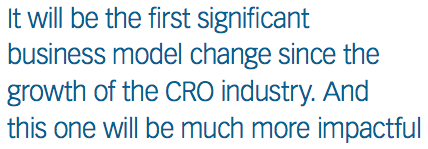Digital Disruption is Coming: Are You Ready?
Pharmaceutical Executive
The steps to stay ahead of the looming shakeup in pharma.
It is the golden age for life sciences. The $1.7 trillion industry is growing faster than most industries-roughly 6% per year. There have been more drug launches over the last two years than any other two-year period in history. Scientists are pushing the frontiers in genomics, microbiology and diagnostics, working with colleagues across healthcare to advance personalized medicine and improve patient outcomes.
We are now talking about significant treatments and cures for diseases that have not been approached in a meaningful way before-and science will continue to evolve rapidly over the next 20 years. However, the commercial business model for life sciences today is still “pre-Internet.” The model has not yet been disrupted. It’s like taxi cabs before Uber, hotels before Airbnb, retail before Amazon, airlines before Sabre. Like all pre-Internet business models, it has two basic problems:
It’s not easy for customers,so they consume less
It’s not easy for a clinical investigator or patient to get involved in a clinical trial, because life sciences companies approach digital channels differently or they don’t leverage them at all. It’s not easy for a healthcare provider to consume information about a new or existing product from life sciences, because each provide the information digitally in a different way. This causes friction, which inevitably lowers consumption. By contrast, people take more vacations because of Airbnb. It’s easier. They shop more online because of Amazon. The same should happen in life sciences.
It’s not efficient
Every life sciences company is reinventing the wheel in many areas-from having every brand across the company figure out its own website, to digital engagement strategy in every country, to identifying key opinion leaders (KOLs) from scratch for each new launch. At the end of the day, patients pay for this inefficiency, which means fewer get treated-and life sciences margins are lower than they could be.
Why no disruption?
Disruption and an Internet business model will come. It always does, because at some point customers are shown an easier way, and they will take that easier path. So, why has it not yet come to life sciences? Companies in this field have much more intellectual property protection than organizations in other industries, so the system can tolerate inefficiencies. Also, there are global and regional government regulations, as well as significant and legitimate safety and compliance concerns. These two factors cause life sciences to be more resistant to-and thoughtful about-digital disruption than other industries.
But change will come. It always does. It’s not clear whether it is two years out or 10 years down the road. When it does come, it will come fast and each company will be forced to change quickly, or be left behind.
When the disruption comes, it will be the first significant business model change since the growth of the CRO industry. And this change will be much more impactful. So, if you believe disruption is coming, but you don’t know when, what can you do about it now?
1. Create efficient internal operations using cloud technology. First, get your internal operations efficient and global, both in commercial and R&D. Move to efficient cloud-based IT systems that are industry standard, represent industry best practices, and always remain up to date in the cloud. You want to get the burden of fragmented systems out of your company, so you can be agile and industry-standard when the disruption comes. You want to modernize your processes and adopt industry-standard processes for basic functions. Because, when the disruption comes, you won’t have time to fix your internal systems. And you won’t be able to fit into the new model if your systems and processes

are not flexible and modern.
2. Support industry collaborations. The industry needs to get together for the benefit of customers. Groups like TransCelerate BioPharma Inc. and others are good for the industry. Industry collaboration to benefit the customer should be top of mind for every biopharma CEO. Coming together with standard approaches is the only way to make it easier for customers. Waiting for regulators around the globe to mandate standard approaches would not be an optimal outcome. Get involved. Be open. Realize that investigators, clinical patients and healthcare providers are not your customers. They are shared customers of the whole life sciences industry, and we need to treat them that way.
So, yes, it takes work, and change is not easy. You have to move information technology to the cloud, and modernize and globalize your processes. You have to focus on industry collaborations instead of only internal operations and quarterly results. You might have to change your company
Illustration courtesy of Veeva

culture to be more collaborative.
3. The hidden benefit of digital disruption in life sciences. For life sciences, specifically, there will be a hidden benefit of digital disruption. Collaboration between R&D and commercial will increase, leading to better patient outcomes.
The long-standing challenge of barriers between R&D and commercial continue to persist. Some represent the company’s internal organizational structure-which should not be imposed upon patients and healthcare providers. These barriers will begin to erode over time with a more unified digital approach that blends R&D and commercial in an appropriate and compliant manner. Digital
can and will provide a unified approach because customers will demand it.
Get prepared
Cloud innovation and adoption will transform the life sciences industry and drive the operating model of the future. The timing is unpredictable, but it will come. The question is: Will you embrace disruption and get ahead of the curve? Or will you wait and then hope you can catch up later?
Embrace the change. It is better for customers, better for the industry and more fulfilling for employees.

Peter Gassner is Founder and CEO of Veeva Systems

Is Artificial Intelligence a ‘Product’? Products Liability Implications for AI-Based Products
April 10th 2025As the physical products we use evolve to become increasingly complex, traditional products liability frameworks may not always fit to provide remedies for harm that can result from using novel product types.